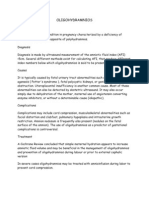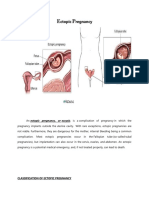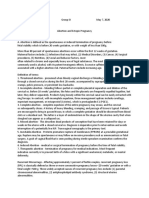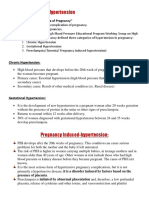Polyhydramnios
Polyhydramnios
Uploaded by
Nathaniel RemandabanCopyright:
Available Formats
Polyhydramnios
Polyhydramnios
Uploaded by
Nathaniel RemandabanCopyright
Available Formats
Share this document
Did you find this document useful?
Is this content inappropriate?
Copyright:
Available Formats
Polyhydramnios
Polyhydramnios
Uploaded by
Nathaniel RemandabanCopyright:
Available Formats
Polyhydramnios Polyhydramnios (polyhydramnion, hydramnios, polyhydramnios) is a medical condition describing an excess of [1][2] [3] amniotic fluid in the amniotic
sac. It is seen in 0.2 to 1.6% of pregnancies, ,. It is typically diagnosed when the [4][5] amniotic fluid index (AFI) is greater than 20 cm ( 20 cm), The opposite to polyhydramnios is oligohydramnios, a deficiency in amniotic fluid. Causes A single case of polyhydramnios may have one or more causes. About 14% of cases are due to maternal diabetes mellitus, which causes fetal hyperglycemia and resulting polyuria (fetal urine is a major source of amniotic fluid) and also rh-isoimmunisation can cause it. About another 20% of cases are associated with fetal anomalies that impair the ability of the fetus to swallow (the fetus normally swallows the amniotic fluid). These anomalies include: y y y y gastrointestinal abnormalities such as esophageal atresia, duodenal atresia, facial cleft, neck masses, and tracheoesophageal fistula fetal renal disorders that results in increased urine production during pregnancy, such as in antenatal Bartter syndrome.[6] Molecular diagnosis is available for these conditions.[7] chromosomal abnormalities such as Down's syndrome and Edwards syndrome (which is itself often associated with GI abnormalities) neurological abnormalities such as anencephaly, which impair the swallowing reflex
It may also be caused by a congenital defect (a congenital diaphragmatic hernia), Bochdalek's hernia, in which the pleuro-peritoneal membranes (especially the left) will fail to develop & seal the pericardio- peritoneal canals. This results in the stomach protrusion up into the thoracic cavity, and the fetus is unable to swallow sufficient amounts of amniotic fluid. In a multiple gestation pregnancy, the cause of polyhydramnios usually is twin-twin transfusion syndrome. It can also be caused by some systemic medical conditions in the mother, including cardiac or kidney problems. it can also be caused by intrauterine infection (TORCH) Additionally, chorioangioma of the placenta can also cause this condition. However, it should be reported that in 60-65% of cases it is unknown why polyhydramnios happens. Diagnosis There are several pathologic conditions that can predispose a pregnancy to polyhydramnios. These include a maternal history of diabetes mellitus, Rh incompatibility between the fetus and mother, intrauterine infection, and multiple pregnancies. During the pregnancy, certain clinical signs may suggest polyhydramnios. In the mother, the physician may observe increased abdominal size out of proportion for her weight gain and gestation age, uterine size that outpaces gestational age, shiny skin with stria (seen mostly in severe polyhydramnios), dyspnea, and chest heaviness. When examining the fetus, faint fetal heart sounds are also an important clinical sign of this condition.
Associated conditions Fetuses with polyhydramnios are at risk for a number of other problems including cord prolapse, placental abruption, premature birth and perinatal death. At delivery the baby should be checked for congenital abnormalities. Another cause of polyhydramnios is skeletal dysplasia, or dwarfism, in the baby. There is a possibility of the chest cavity not being large enough to house all of the baby's organs causing the trachea and esophagus to be restricted, not allowing the baby to swallow the appropriate amount of amniotic fluid. [edit] Treatment y y y Mild asymptomatic polyhydraminos is managed expectantly. For a woman with symptomatic polyhydrminos may need hospital admission. Antacids may be prescribed to relive heartburn and nausea. [citation needed] Dietary salt restriction is recommended. In some cases, amnioreduction, also known as therapeutic Amniocentesis, has been used in response to polyhydramnios.[8]
You might also like
- Polyhydramnios & Oligohydramnios: Prepared By: Hamzah Qarawi To: Miss Mahdia KonyDocument37 pagesPolyhydramnios & Oligohydramnios: Prepared By: Hamzah Qarawi To: Miss Mahdia KonyNinaNo ratings yet
- Polyhydramnios 10Document4 pagesPolyhydramnios 10hussain AltaherNo ratings yet
- OLIGOHYDRAMNIOSDocument3 pagesOLIGOHYDRAMNIOSRuzzel Cabrera-BermonteNo ratings yet
- Vacuum Extraction (Ventouse)Document3 pagesVacuum Extraction (Ventouse)dusty kawiNo ratings yet
- Midwifery Pharmacology-2Document2 pagesMidwifery Pharmacology-2georgeloto12No ratings yet
- Multiple PregnancyDocument20 pagesMultiple PregnancyNurul Fahmiza TumiranNo ratings yet
- MCNDocument12 pagesMCNIan CarodanNo ratings yet
- LGADocument5 pagesLGAfaye kimNo ratings yet
- Inversion of Uterus 170225210149Document54 pagesInversion of Uterus 170225210149anju kumawatNo ratings yet
- Pephalo Pelvicdisproportion &contracted PelvisDocument38 pagesPephalo Pelvicdisproportion &contracted PelvisAltynaiNo ratings yet
- Ectopic Pregnancy - OMDocument9 pagesEctopic Pregnancy - OMrheind100% (1)
- Dysfunctional Labour by Abhishek JaguessarDocument34 pagesDysfunctional Labour by Abhishek Jaguessarreedoye21No ratings yet
- Hyper Emesis GravidarumDocument22 pagesHyper Emesis Gravidarumchandu ranaNo ratings yet
- Case StudyDocument48 pagesCase Studysimbarashe tangwadzanaNo ratings yet
- Threatened AbortionDocument1 pageThreatened AbortionKEn PilapilNo ratings yet
- Hydatifor M Mole: By: Namita Arya Asst. Lecturer PDMSNCDocument27 pagesHydatifor M Mole: By: Namita Arya Asst. Lecturer PDMSNCnamita100% (1)
- Gestational Trophoblastic DiseaseDocument4 pagesGestational Trophoblastic DiseasePrincess PlateroNo ratings yet
- Abortion and Ectopic PregnancyDocument3 pagesAbortion and Ectopic PregnancyJefelson Eu Palaña NahidNo ratings yet
- Gestational Diabetes Mellitus Gestational Diabetes Mellitus (GDM) Is One of TheDocument10 pagesGestational Diabetes Mellitus Gestational Diabetes Mellitus (GDM) Is One of TheJobelle AcenaNo ratings yet
- Respiratory Distress SyndromeDocument121 pagesRespiratory Distress Syndromeinno so qtNo ratings yet
- Puerperium & Puerperal SepsisDocument15 pagesPuerperium & Puerperal SepsisMohammad HafizNo ratings yet
- AbortionDocument62 pagesAbortionRaj KumarNo ratings yet
- OligohydramniosDocument4 pagesOligohydramniossalamredNo ratings yet
- Before Starting The Presentation, I Am Requesting You All To Get A HandkerchiefDocument35 pagesBefore Starting The Presentation, I Am Requesting You All To Get A HandkerchiefOng KarlNo ratings yet
- Module 5 Induction and Augmentation of LaborDocument17 pagesModule 5 Induction and Augmentation of LaborZyrene RiveraNo ratings yet
- Normal Labor: Ms. Mayuri Patel Sandra Shroff Rofel College of Nursing, VapiDocument48 pagesNormal Labor: Ms. Mayuri Patel Sandra Shroff Rofel College of Nursing, Vapivimmy47100% (1)
- Postpartum ComplicationsDocument21 pagesPostpartum ComplicationsRoccabeth Villanueva100% (1)
- Abruptio Placentae: ALCANTARA, Eduardo L. Ms. Analinda R. Sese, RN, MANDocument45 pagesAbruptio Placentae: ALCANTARA, Eduardo L. Ms. Analinda R. Sese, RN, MANinscenekivir100% (1)
- Incomplete AbortionDocument18 pagesIncomplete AbortionAra DirganNo ratings yet
- Infant of Diabetic MotherDocument1 pageInfant of Diabetic MotherMithlesh DewanganNo ratings yet
- DystociaDocument17 pagesDystociaKarinaNo ratings yet
- NCM - Pregancy Induced HypertensionDocument5 pagesNCM - Pregancy Induced HypertensionZam PamateNo ratings yet
- Journal Gadar Choking-Managing The Risk of Choking GuidelinesDocument18 pagesJournal Gadar Choking-Managing The Risk of Choking GuidelinesnurulNo ratings yet
- DM in PregDocument32 pagesDM in Pregbryanpei23No ratings yet
- Abdominal Pain During PregnancyDocument64 pagesAbdominal Pain During Pregnancykhadzx100% (2)
- Postpartum Hemorrhage PPHDocument70 pagesPostpartum Hemorrhage PPHLoungayvan BatuyogNo ratings yet
- Harika Priyanka. K Asst. Professor AconDocument30 pagesHarika Priyanka. K Asst. Professor AconArchana MoreyNo ratings yet
- DystociaDocument31 pagesDystociamarsan120% (1)
- CPD, Dystocia, Fetal Distress OutputDocument8 pagesCPD, Dystocia, Fetal Distress OutputJohn Dave AbranNo ratings yet
- Amniotic FluidDocument34 pagesAmniotic Fluidannu panchalNo ratings yet
- Puerperal SepsisDocument4 pagesPuerperal SepsisSonali NayakNo ratings yet
- Fetal DistressDocument19 pagesFetal DistressAnnisa DentinNo ratings yet
- #3 Cesarean SectionDocument20 pages#3 Cesarean SectionDunice Lloyd Mata100% (1)
- And Vaginal Bleeding (In Ruptured Ectopic Pregnancy)Document9 pagesAnd Vaginal Bleeding (In Ruptured Ectopic Pregnancy)Clareen JuanicoNo ratings yet
- Pelvic Inflammatory DiseaseDocument15 pagesPelvic Inflammatory DiseaseJay PaulNo ratings yet
- Abruptio PlacentaDocument3 pagesAbruptio PlacentaNano KaNo ratings yet
- Hydatidiform MoleDocument10 pagesHydatidiform MoleLisa TurnerNo ratings yet
- RH IncompatibilityDocument35 pagesRH Incompatibilityaparna100% (1)
- Hyperemesis GravidarumDocument16 pagesHyperemesis GravidarumArra MayNo ratings yet
- Hydatidiform MoleDocument3 pagesHydatidiform MoleJny SherpaNo ratings yet
- Placenta Previa and Abruptio Placenta: Prepared By: Largo, Cyd Antang, MicahDocument32 pagesPlacenta Previa and Abruptio Placenta: Prepared By: Largo, Cyd Antang, MicahNi Ki Ta100% (1)
- Antepartum HaemorrhageDocument48 pagesAntepartum HaemorrhageDuncan JacksonNo ratings yet
- Multiple PregnancyDocument16 pagesMultiple Pregnancyjane7arian7berzabalNo ratings yet
- Malpresentations: Liji Raichel Kurian Dept of OBGDocument41 pagesMalpresentations: Liji Raichel Kurian Dept of OBGliji raichel kurian100% (1)
- Retained Placenta After Vaginal Birth and Length of The Third Stage of Labor - UpToDateDocument19 pagesRetained Placenta After Vaginal Birth and Length of The Third Stage of Labor - UpToDateHartanto Lie100% (1)
- Pregnancy Induced HypertensionDocument52 pagesPregnancy Induced HypertensionJoy GloryNo ratings yet
- Amniotic Fluid DisordersDocument22 pagesAmniotic Fluid Disordersvictor onapaNo ratings yet
- Birth Asphyxia: by Anne E. Odaro MCM/2017/69852Document26 pagesBirth Asphyxia: by Anne E. Odaro MCM/2017/69852ElvisNo ratings yet
- Hirschsprung’s Disease, A Simple Guide To The Condition, Diagnosis, Treatment And Related ConditionsFrom EverandHirschsprung’s Disease, A Simple Guide To The Condition, Diagnosis, Treatment And Related ConditionsNo ratings yet



























































